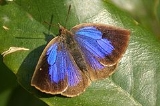
Arhopala
Encyclopedia
Arhopala is a very large genus
of gossamer-winged butterflies (Lycaenidae). They are the type genus
of the tribe
Arhopalini
. In the relatively wide circumscription used here, it contains over 200 species
collectively known as oakblues. They occur from Japan
throughout temperate
to tropical Asia
south and east of the Himalayas
to Australia
and the Solomon Islands
of Melanesia
. Like in many of their relatives, their caterpillar
s are attended and protected by ant
s; sexual dichromatism is often prominent in adult oakblues.
The genus' delimitation versus Amblypodia
and Flos
has proven to be problematic; not all issues are resolved and the assignment of species to these genera must be considered somewhat provisional.
The species have been provisionally sorted into groups of presumed closest relatives, but many species remain insufficiently studied even for such a preliminary assessment at present. For example, A. phryxus – the type species
used by Jean Baptiste Boisduval
when he described Arhopala in 1832 – was established at the same time as and specifically for this genus. It is presently considered a valid species of unclear affiliations, but it is suspected that Boisduval's taxon
is a junior synonym of A. thamyras – the namesake of its species-group – which had been described as Papilio thamyras by Carl Linnaeus in 1764 already.
Molecular phylogenetic studies have only sampled a fraction of the known diversity of oakblues, but as it seems at least some of the groups represent clades that could justifiably be treated as subgenera. It is also to be seen, however, if the genus is monophyletic in the loose sense as used here, or would need to be split up again.
are listed alphabetically, while the groups are listed in the presumed phylogenetic sequence:
.jpg)



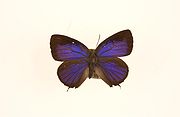
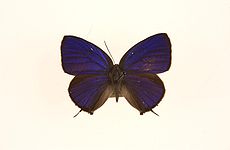
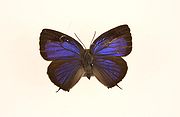
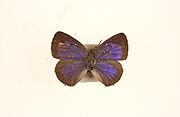 Incertae sedis
Incertae sedis
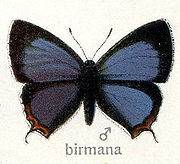
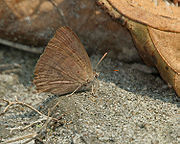
Genus
In biology, a genus is a low-level taxonomic rank used in the biological classification of living and fossil organisms, which is an example of definition by genus and differentia...
of gossamer-winged butterflies (Lycaenidae). They are the type genus
Type genus
In biological classification, a type genus is a representative genus, as with regard to a biological family. The term and concept is used much more often and much more formally in zoology than it is in botany, and the definition is dependent on the nomenclatural Code that applies:* In zoological...
of the tribe
Tribe (biology)
In biology, a tribe is a taxonomic rank between family and genus. It is sometimes subdivided into subtribes.Some examples include the tribes: Canini, Acalypheae, Hominini, Bombini, and Antidesmeae.-See also:* Biological classification* Rank...
Arhopalini
Arhopalini
The Arhopalini are a rather small tribe of butterflies in the family Lycaenidae. As not all Theclinae have been assigned to tribes, the genus list is preliminary.-Genera:ApporasaArhopalaFlosKeraunogrammaMahathalaMotaOgyris...
. In the relatively wide circumscription used here, it contains over 200 species
Species
In biology, a species is one of the basic units of biological classification and a taxonomic rank. A species is often defined as a group of organisms capable of interbreeding and producing fertile offspring. While in many cases this definition is adequate, more precise or differing measures are...
collectively known as oakblues. They occur from Japan
Japan
Japan is an island nation in East Asia. Located in the Pacific Ocean, it lies to the east of the Sea of Japan, China, North Korea, South Korea and Russia, stretching from the Sea of Okhotsk in the north to the East China Sea and Taiwan in the south...
throughout temperate
Temperate
In geography, temperate or tepid latitudes of the globe lie between the tropics and the polar circles. The changes in these regions between summer and winter are generally relatively moderate, rather than extreme hot or cold...
to tropical Asia
Asia
Asia is the world's largest and most populous continent, located primarily in the eastern and northern hemispheres. It covers 8.7% of the Earth's total surface area and with approximately 3.879 billion people, it hosts 60% of the world's current human population...
south and east of the Himalayas
Himalayas
The Himalaya Range or Himalaya Mountains Sanskrit: Devanagari: हिमालय, literally "abode of snow"), usually called the Himalayas or Himalaya for short, is a mountain range in Asia, separating the Indian subcontinent from the Tibetan Plateau...
to Australia
Australia
Australia , officially the Commonwealth of Australia, is a country in the Southern Hemisphere comprising the mainland of the Australian continent, the island of Tasmania, and numerous smaller islands in the Indian and Pacific Oceans. It is the world's sixth-largest country by total area...
and the Solomon Islands
Solomon Islands
Solomon Islands is a sovereign state in Oceania, east of Papua New Guinea, consisting of nearly one thousand islands. It covers a land mass of . The capital, Honiara, is located on the island of Guadalcanal...
of Melanesia
Melanesia
Melanesia is a subregion of Oceania extending from the western end of the Pacific Ocean to the Arafura Sea, and eastward to Fiji. The region comprises most of the islands immediately north and northeast of Australia...
. Like in many of their relatives, their caterpillar
Caterpillar
Caterpillars are the larval form of members of the order Lepidoptera . They are mostly herbivorous in food habit, although some species are insectivorous. Caterpillars are voracious feeders and many of them are considered to be pests in agriculture...
s are attended and protected by ant
Ant
Ants are social insects of the family Formicidae and, along with the related wasps and bees, belong to the order Hymenoptera. Ants evolved from wasp-like ancestors in the mid-Cretaceous period between 110 and 130 million years ago and diversified after the rise of flowering plants. More than...
s; sexual dichromatism is often prominent in adult oakblues.
The genus' delimitation versus Amblypodia
Amblypodia
Amblypodia is a genus of butterfly in the family Lycaenidae. Several species formerly placed here are now in Arhopala and Flos, although this placement is not necessarily definite.The remaining species of Amblypodia are:...
and Flos
Flos
Flos is also the name of a mathematical work by Fibonacci.Flos is a genus of butterfly in the family Lycaenidae....
has proven to be problematic; not all issues are resolved and the assignment of species to these genera must be considered somewhat provisional.
Systematics
As circumscribed here, this genus includes many formerly independent genera. Junior synonyms of Arhopala are:- Acesina Moore, 1884
- Aurea Evans, 1957
- Daranasa Moore, 1884 (lapsusLapsusA lapsus is an involuntary mistake made while writing or speaking. According to Freud's early psychoanalytic theory, a lapsus represents a missed deed that hides an unconscious desire....
) - Darasana Moore, 1884
- "Iois" Doherty, 1899 (nomen nudumNomen nudumThe phrase nomen nudum is a Latin term, meaning "naked name", used in taxonomy...
) - Narathura Moore, 1879
- Nilasera Moore, 1881
- Panchala Moore, 1882
- Satadra Moore, 1884
The species have been provisionally sorted into groups of presumed closest relatives, but many species remain insufficiently studied even for such a preliminary assessment at present. For example, A. phryxus – the type species
Type species
In biological nomenclature, a type species is both a concept and a practical system which is used in the classification and nomenclature of animals and plants. The value of a "type species" lies in the fact that it makes clear what is meant by a particular genus name. A type species is the species...
used by Jean Baptiste Boisduval
Jean Baptiste Boisduval
Jean Baptiste Alphonse Dechauffour de Boisduval was a French lepidopterist and physician. He developed the Boisduval scale and identified many new species of butterflies. One of the most celebrated lepidopterists of France, he was the co-founder of the Société Entomologique de France...
when he described Arhopala in 1832 – was established at the same time as and specifically for this genus. It is presently considered a valid species of unclear affiliations, but it is suspected that Boisduval's taxon
Taxon
|thumb|270px|[[African elephants]] form a widely-accepted taxon, the [[genus]] LoxodontaA taxon is a group of organisms, which a taxonomist adjudges to be a unit. Usually a taxon is given a name and a rank, although neither is a requirement...
is a junior synonym of A. thamyras – the namesake of its species-group – which had been described as Papilio thamyras by Carl Linnaeus in 1764 already.
Molecular phylogenetic studies have only sampled a fraction of the known diversity of oakblues, but as it seems at least some of the groups represent clades that could justifiably be treated as subgenera. It is also to be seen, however, if the genus is monophyletic in the loose sense as used here, or would need to be split up again.
Species
SpeciesSpecies
In biology, a species is one of the basic units of biological classification and a taxonomic rank. A species is often defined as a group of organisms capable of interbreeding and producing fertile offspring. While in many cases this definition is adequate, more precise or differing measures are...
are listed alphabetically, while the groups are listed in the presumed phylogenetic sequence:
.jpg)







Incertae sedis
, is a term used to define a taxonomic group where its broader relationships are unknown or undefined. Uncertainty at specific taxonomic levels is attributed by , , and similar terms.-Examples:*The fossil plant Paradinandra suecica could not be assigned to any...



